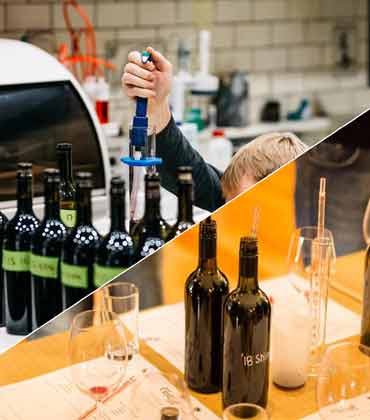THANK YOU FOR SUBSCRIBING
By Angelos Kyrousis, Director of Food and Beverage, Virgin Hotels
Exploring the art of Wine and Food Pairing: A Gateway to...
By Leandro Moretti, Research and Development Director, Marley Spoon
The Rise of Wine Tourism in Europe
By Aoife Murphy, Winery Operations Manager,Glanbia
How European Wineries are Blending Tradition with...

Defending the Plate: Strategies to Combat Foodborne Pathogens in Food Manufacturing
Riaz Ahamadeen, Vice President of Quality/Food Safety & Regulatory – North America, Oatly

 Riaz Ahamadeen, Vice President of Quality/Food Safety & Regulatory – North America, Oatly
Riaz Ahamadeen, Vice President of Quality/Food Safety & Regulatory – North America, Oatly The battle against foodborne pathogens remains an ongoing challenge in today's food manufacturing industry. The consequences of contamination can be dire, not just for consumer health but also for a company's reputation and bottom line. A multifaceted approach is required to successfully navigate this landscape, encompassing stringent protocols, advanced technologies, and a holistic culture committed to food safety.
Keeping Foodborne Pathogens Out – Why it matters
The importance of keeping foodborne pathogens out of the production process cannot be overstated. Pathogens like Salmonella, E. coli, Listeria, and others pose severe health risks, leading to illnesses, hospitalizations, and even fatalities. Moreover, outbreaks can result in massive recalls, lawsuits, damage to brand reputation, and substantial financial losses to the companies.
"By integrating robust protocols, stringent measures, cutting-edge technologies, and a steadfast dedication to a food safety culture, it is possible to mitigate the risks and protect consumers from the grave consequences of contamination."
Hygienic & Sanitary Facility and Equipment Design
The foundation of preventing foodborne pathogens starts with the design of facilities and equipment. Implementing stainless steel surfaces, ensuring proper drainage, minimizing crevices, and using equipment designed for easy cleaning and sanitation are essential. An environment designed with hygiene significantly reduces the risk of pathogen contamination.
Highly Effective Engineering and Maintenance Programs
Regular maintenance and efficient engineering practices are crucial. Machinery breakdowns or malfunctions can create environments conducive to pathogen growth. Strict maintenance schedules, equipment testing, prompt repairs and hygienic maintenance equipment release procedures are imperative to uphold the integrity of the production process.
Microbiological Risk Analysis Methods on the HACCP/Food Safety Plan
Incorporating highly effective microbiological risk analysis methods into the Hazard Analysis and Critical Control Points (HACCP) and the Food Safety Plan is pivotal.
This involves thoroughly assessing potential hazards in ingredients and packaging materials at each stage of production and implementing preventive measures to mitigate these risks.
Ingredients and Raw Material Quality
The quality of ingredients and raw materials directly impacts the safety of the final product. Rigorous supplier vetting, ingredient risk analysis, testing, and adherence to strict quality standards ensure that the materials entering the production chain are free from pathogens and contaminants.
Effective Production Process Controls
Implementing precise controls throughout the production process is vital. Monitoring critical control points and ensuring proper temperatures, times, and conditions during processing significantly reduces the risk of pathogen proliferation.
Excellent Employee Training & Education
Employees are the frontline defense against foodborne pathogens. Comprehensive training on GMP/hygiene practices, proper handling procedures, and protocols for identifying and reporting potential risks is imperative. Continuous education and reinforcement of best practices are essential components of a robust food safety strategy.
Food Safety Culture
Instilling a pervasive food safety culture within the organization is paramount. It involves fostering a mindset where every individual from the top down prioritizes and values food safety above all else. Encouraging open communication, accountability, and a zero-tolerance policy for deviations from safety protocols reinforces the food safety culture.
Effective Cleaning and Sanitation Standards, Policy, and Procedures
Implementing stringent cleaning and sanitation standards is non-negotiable. Establishing comprehensive protocols for master sanitation schedules and sanitation methods and using approved disinfectants are crucial steps in eliminating potential sources of contamination such as biofilms and micro harborages.
Highly Effective Environmental Pathogen Monitoring Program
Constant vigilance through environmental pathogen monitoring is critical. Establishing hygienic zoning, where different areas are categorized based on their risk level, allows for targeted monitoring and control measures to prevent cross-contamination.
The “Seek and Destroy” approach involves rigorous and systematic efforts to identify potential sources of contamination, such as surfaces, equipment, or areas where pathogens might thrive. Once identified, these areas are thoroughly cleaned, sanitized, and sometimes even sterilized to eliminate any traces of pathogens.
GFSI and FDA/FSMA “Risk-Based Preventive Controls” and Compliance
Adhering to globally recognized Food Safety Standards like the Global Food Safety Initiative (GFSI) Audit Schemes such as SQF, BRC, FSSC, IFS and FDA's Food Safety Modernization Act (FSMA) "Risk-Based Preventive Controls" ensures a systematic approach to food safety. Compliance with these regulations sets a benchmark for best practices in the industry.
Excellent Cleaning and Sanitation Validation and Verification Programs/Procedures
Validation and verification of cleaning and sanitation processes are essential to ensure their effectiveness. Regular audits, testing, and validation procedures verify that the implemented protocols eliminate pathogens and prevent their re-emergence.
Excellent Finished Products Positive Release Procedures
Implementing stringent protocols for the release of finished products is crucial. Each batch should undergo thorough testing and inspection to meet safety standards before reaching consumers.
Sanitary Warehousing, Storage, and Transportation
Maintaining the integrity of the product beyond the manufacturing stage is vital. Proper storage conditions and transportation practices that prevent cross-contamination are essential to ensure the product's safety until it reaches the consumer.
Effective Pest Control Programs
Pests can be vectors for pathogens, making effective pest control programs indispensable. Implementing measures to prevent pest entry, regular inspections, and immediate action against any signs of infestation are critical components of a comprehensive food safety strategy.
Internal Audits
Regular internal audits are indispensable for identifying areas of improvement and ensuring compliance with established protocols. Conducting thorough and systematic internal audits helps address potential risks and vulnerabilities and enhance food safety measures.
Conclusion
The fight against foodborne pathogens demands a comprehensive and unwavering commitment from every facet of the food manufacturing industry. By integrating robust protocols, stringent measures, cutting-edge technologies, and a steadfast dedication to a food safety culture, it is possible to mitigate the risks and protect consumers from the grave consequences of contamination. Upholding these standards not only ensures compliance with regulations but also fosters consumer trust, safeguarding both public health and the reputation of the food industry.
Read Also















